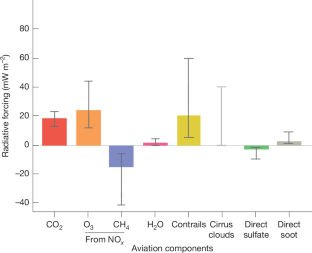2025-07-02 カリフォルニア大学アーバイン校(UCI)
<関連情報>
- https://news.uci.edu/2025/07/02/smarter-flight-decisions-can-cool-the-planet-uc-irvine-study-shows/
- https://www.nature.com/articles/s41586-025-09198-2
航空機が気候に与える影響におけるトレードオフは、CO2以外の緩和策を支持する Trade-offs in aviation impacts on climate favour non-CO2 mitigation
Michael J. Prather,Andrew Gettelman & Joyce E. Penne
Nature Published:02 July 2025
DOI:https://doi.org/10.1038/s41586-025-09198-2

Abstract
Climate assessments of civil aviation1,2 have consistently quantified the dominant climate-forcing components: (1) CO2 emissions, (2) NOx (NO + NO2) emissions and (3) persistent contrails. All three components exert a positive radiative forcing (RF) and lead to climate warming of similar magnitudes. The aviation community is actively seeking to reduce its climate footprint through advanced engine technologies, more sustainable aviation fuel and optimal routing plans3,4,5,6,7,8,9,10,11,12. These approaches usually involve a trade-off of CO2 against NOx or contrails (non-CO2), such as burning 1% more fuel to decrease contrail RF by 4%. Here, we show that a climate-trade-off risk curve derived from uncertainties in the RF components2,13,14,15,16 can give the probability that a specified trade-off ratio will produce a climate benefit. For each component, we calculate the integrated effective RF resulting from 1 year of flights: global warming per activity (GWA). The complementary cumulative probability distribution of the GWA(non-CO2) to GWA(CO2) ratio results in a climate-trade-off risk curve giving the likelihood of a positive climate outcome as a function of the trade-off-CO2 to trade-off-non-CO2 ratio, because the product, GWA × trade-off, should be the same for both. We find a likely (67%) chance of climate mitigation on a 100-year time horizon for the above suggested ratio of 1:4, favouring proposed non-CO2 mitigation efforts3,4,5,6,7,8,9,10,11,12 with ratios smaller than this.



